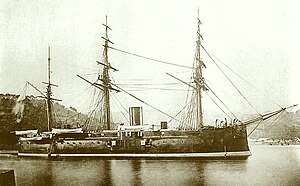Japanese ironclad Fuso

Fusō as completed
|
|
| History | |
|---|---|
|
|
|
| Name: | Fusō (Japanese: 扶桑) |
| Namesake: | Classical name for Japan |
| Ordered: | 24 September 1875 |
| Builder: | Samuda Brothers, Cubitt Town, London |
| Laid down: | 24 September 1875? |
| Launched: | 17 April 1877 |
| Completed: | January 1878 |
| Reclassified: | Coast defense ship, December 1905 |
| Struck: | 1 April 1908 |
| Fate: | Sold for scrap, 1909 |
| General characteristics (as built) | |
| Type: | Central-battery ironclad |
| Displacement: | 3,717 long tons (3,777 t) |
| Length: | 220 ft (67.1 m) |
| Beam: | 48 ft (14.6 m) |
| Draft: | 18 ft 5 in (5.6 m) |
| Installed power: | |
| Propulsion: | 2 shafts, 2 trunk steam engines |
| Sail plan: | Barque rigged |
| Speed: | 13 knots (24 km/h; 15 mph) |
| Range: | 4,500 nmi (8,300 km; 5,200 mi) at 10 knots (19 km/h; 12 mph) |
| Complement: | 295 |
| Armament: |
|
| Armor: | |
Fusō (扶桑?) was a central-battery ironclad built for the Imperial Japanese Navy (IJN) in the 1870s. She was built in the United Kingdom because such ships could not yet be constructed in Japan. The ship participated in the First Sino-Japanese War of 1894–95 where she was damaged during the Battle of the Yalu River in 1894 and participated in the Battle of Weihaiwei in early 1895. She collided with two Japanese ships during a storm and sank in 1897. She was refloated the following year and repaired. Fusō played a minor role in the Russo-Japanese War of 1904–05 and was reclassified as a coast defense ship after the war. She was struck from the Navy List in 1908 and sold for scrap the following year.
Tensions between Japan and China heightened after the former launched its punitive expedition against Taiwan in May 1874 in retaliation of the murder of a number of shipwrecked sailors by the Paiwan aborigines. China inquired into the possibility of buying ironclad warships from Great Britain and Japan was already negotiating with the Brazilian government about the purchase of the ironclad Independencia then under construction in Britain. The Japanese terminated the negotiations with the Brazilians in October after the ship was badly damaged upon launching and the expeditionary force was about to withdraw from Taiwan. The crisis illustrated the need to reinforce the IJN and a budget request was submitted that same month by Acting Navy Minister Kawamura Sumiyoshi for ¥3.9–4.2 million to purchase three warships from abroad. No Japanese shipyard was able to build ships of this size so they were ordered from Great Britain. This was rejected as too expensive and a revised request of ¥2.3 million was approved later that month. Nothing was done until March 1875 when Kawamura proposed to buy one ironclad for half of the money authorized and use the rest for shipbuilding and gun production at the Yokosuka Shipyard. No response was made by the Prime Minister's office before the proposal was revised to use all of the allocated money to buy three ships, one iron-hulled armored warship and two armored corvettes of composite construction to be designed by the prominent British naval architect Sir Edward Reed, formerly the Chief Constructor of the Royal Navy. Reed would also supervise the construction of the ships for an honorarium of five percent of the construction cost. The Prime Minister's office approved the revised proposal on 2 May and notified the Japanese consul, Ueno Kagenori, that navy officers would be visiting to negotiate the contract with Reed.
...
Wikipedia
